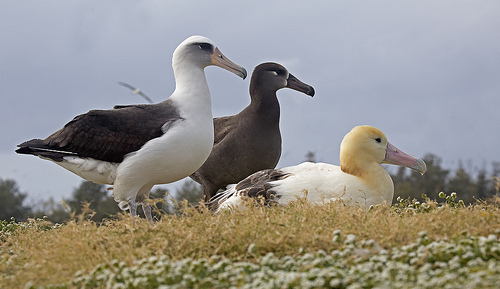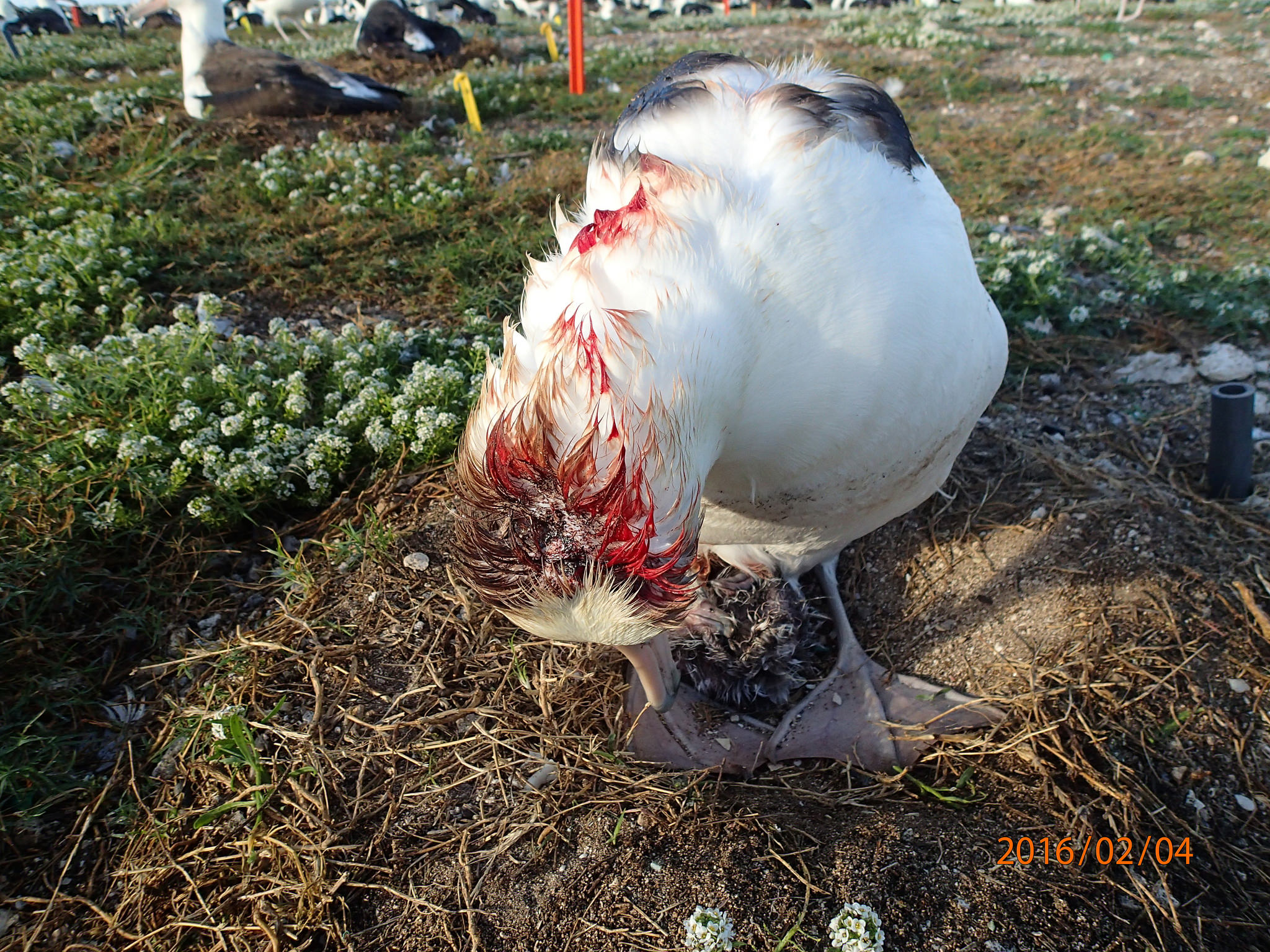Mice Attacks on Albatross Prompt Proposed Removal From Midway
The US Fish and Wildlife Service is proposing to remove the invasive house mouse from Midway Atoll in an effort to protect seabird colonies.

A Rare Find Photo Op by: Dan Clark/USFWS Midway Atoll. Laysan albatross (left), black-footed albatross (center) and short-tailed albatross (right), face into the wind on Midway Atoll NWR in a family portrait moment of all the albatross species that range exclusively in the North Pacific.
According to the Service, mice are attacking nesting albatross at Midway, which has the largest albatross colony in the world and is recognized as the most important and successful breeding ground for black-footed albatross and Laysan albatross.
“In just a few years, mice attacks have increased from just a few incidents to hundreds of widespread attacks on albatross that result in injury, nest abandonment and death,” according to officials.
A draft environmental assessment for the project is now available for public comment from March 21 – April 20.
Within Papahānaumokuākea Marine National Monument, Midway Atoll National Wildlife Refuge and Battle of Midway National Memorial support over three million birds from 30 different species. Nearly 40% of all Black-footed albatross and 70% of all Laysan albatross in the world rely on the approximately 1,500 acres of islands that comprise the remote atoll.

Laysan Albatross (Moli) with visible head wound. Photo credit: USFWS. Mice are preying on nesting albatross on Midway Atoll National Wildlife Refuge and the Battle of Midway National Monument, part of the Papahānaumokuākea Marine National Monument.
Authorities say seabirds face a myriad of threats – from fishery interactions and marine debris to invasive species and shrinking habitat. Safe places like Midway Atoll, where seabirds can rest and raise their young, are considered critical for their ability to survive into the future.
Non-native, invasive house mice and black rats became established on Midway Atoll’s Sand Island more than 75 years ago, before it was a refuge and memorial. House mice reportedly persisted after black rats were eradicated in 1996 and are now the sole rodent and non-native mammal present in the Monument.
Biologists do not yet know what triggered the mice to begin preying on the albatross. Mice are omnivores – meaning that they will eat any source of food they can find in their quest to survive – and although they had been present on Midway Atoll for decades, there had never been a documented case of predation on adult albatross by mice before the 2015 hatching season.
The majority of seabird extinctions around the world have been caused by invasive mammals, in particular non-native rodents. For most of the island’s history, there were no rodents on Midway Atoll. Pacific seabirds like the albatross evolved without any fear or defense mechanisms against mammalian predators like mice, rats, cats, dogs, or humans.
Authorities say that part of the danger to the colony is that mice reproduce very quickly compared to albatrosses, which have a very slow reproductive cycle. Albatross pairs only have one egg every one to two years, and both parents invest a lot of energy into hatching and raising that chick. The incredible amount of time and work necessary for albatrosses to survive to adulthood, find a mate, and become a successful parent means that each adult bird is incredibly important to the overall survival of the colony.
Their lack of defense mechanisms and complete dedication to their eggs has left albatrosses vulnerable to predation. Their slow reproductive cycle means that losses to the colony from being preyed on by mice will continue to impact the population for decades to come.
“This was something we had never expected to occur. Mice preying on adult albatrosses simply hasn’t been recorded here,” said Matt Brown, Superintendent for the U.S. Fish and Wildlife Service in Papahānaumokuākea Marine National Monument. “Regardless of what caused them to start this behavior, it has the potential to cause an incredible amount of damage to this colony. And it’s a problem that we have to address.”
The proposed action to remove mice from Midway Atoll and the alternatives considered are evaluated in a draft environmental assessment. To date, there have been more than 500 successful projects to remove invasive rodents from islands, and the proposed project on Midway Atoll models similar, successful projects elsewhere.
The Service has coordinated with the Monument co-managers and worked with Island Conservation, American Bird Conservancy, National Fish and Wildlife Foundation, National Oceanic and Atmospheric Administration and other members of the conservation community in the synthesis and development of the science that contributed to the development of the draft environmental assessment.
All relevant comments and information received by April 20, 2018, will be considered. The draft EA is available for review online. Public comments on the draft EA can be submitted:
Via email: [email protected]; or
Via mail to: Attn: Midway Draft EA Comments, Pacific Islands Refuges and Monuments Office, 300 Ala Moana Blvd., Room 5-231, Honolulu, HI, 96850.










